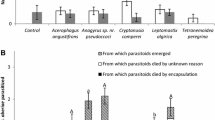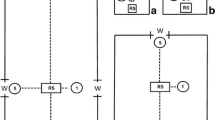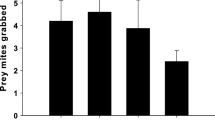Abstract
Venturia canescens and Habrobracon hebetor are cosmopolitan parasitoids found in large numbers in food processing facilities in northeastern Spain and in many other countries. These parasitoids attack larvae of pyralid moths, which are important pests of stored products and food industries worldwide. In this study, we evaluated the performance of these two parasitoids when offered single or combined populations of Plodia interpunctella and Ephestia kuehniella, since these can occur together in storehouses. We tested the parasitoid’s performance in small cages under laboratory conditions and small experimental storerooms (≈ 30 m3). In the laboratory, the two parasitoids were able to reduce pyralid populations by more than 37% over a 48-h period (40–44% for E. kuehniella, 37–41% of P. interpunctella and 53–55% of both hosts when offered together). Similar results were obtained in small storerooms after 10 days: a > 35% reduction in pyralid populations also was obtained when host species were offered either singly (E. kuehniella or P. interpunctella) or in combination (E. kuehniella + P. interpunctella) (35–57% for E. kuehniella, 40–54% of P. interpunctella and 41–46% of both hosts when offered together). Parasitism was consistently good from June through November (mean temperatures from 18 to 28 °C and 9.5 to 15 h of daylight). Therefore, both parasitoids, single or in combination, can be efficient biological control agents of these two pyralid moths when infesting stored food facilities.




Similar content being viewed by others
References
Abbott WS (1925) A method for computing the effectiveness of an insecticide. J Econ Entomol 18:265–267
Adarkwah C, Schöller M (2012) Biological control of Plodia interpunctella (Lepidoptera: Pyralidae) by single and double releases of two larval parasitoids in bulk stored wheat. J Stored Prod Res 51:1–5
Akinkurolere RO, Boyer S, Chen H, Zhang H (2009) Parasitism and host-location preference in Habrobracon hebetor (Hymenoptera: Braconidae): role of refuge, choice, and host instar. J Econ Entomol 102:610–615
Athanassiou CG, Saitanis CJ (2006) Spatiotemporal clustering and association of Ephestia kuehniella (Lepidoptera: Pyralidae) and two of its parasitoids in bulk-stored wheat. J Econ Entomol 99:2191–2201
Attia FI, Shipp E, Shanahan GJ (1979) Survey of insecticide resistance in Plodia interpunctella (Hübner), Ephestia cautella (Walker) and Ephestia kuehniella Zeller (Lepidoptera, Pyralidae) in New South Wales. J Aust Entomol Soc 18:67–70
Belda C, Riudavets J (2012) The influence of the rearing host on the response of the parasitoid Venturia canescens (Gravenhorst) (Hymenoptera: Ichneumonidae) to odours from Ephestia kuehniella and Plodia interpunctella in a Y-tube olfactometer. Biocontrol 50:801–808
Belda C, Riudavets J (2013) Natural enemies associated with lepidopteran pests in food and feed processing companies. J Stored Prod Res 53:54–60
Belda C, Ribes-Dasi M, Riudavets J (2011) Improving pest management in pet food mills using accurate monitoring and spatial analysis. J Stored Prod Res 47:385–392
Campolo O, Verdone M, Laudani F, Malacrinò A, Chiera E, Palmeri V (2013) Response of four stored products insects to a structural heat treatment in a flour mill. J Stored Prod Res 54:54–58
Cox PD, Bell CH (1991) Biology and ecology of moth pests of stored foods. In: Gorham JR (ed) Ecology and management of food-industry pests. FDA technical bulletin 4, Association of Official Analytical Chemists, Arlington, VA, pp 181–193
Darwish E, El-Shazly M, El-Sherif H (2003) The choice of probing sites by Bracon hebetor Say (Hymenoptera: Braconidae) foraging for Ephestia kuehniella Zeller (Lepidoptera: Pyralidae). J Stored Prod Res 39:265–276
Desouhant E, Driessen G, Lapchin L, Wielaard S, Bernstein C (2003) Dispersal between host populations in field conditions: navigation rules in the parasitoid Venturia canescens. Ecol Entomol 28:257–267
Desouhant E, Driessen G, Amat I, Bernstein C (2005) Host and food searching in a parasitic wasp Venturia canescens: a trade-off between current and future reproduction? Anim Behav 70:145–152
Eliopoulos PA (2006) Life tables of Venturia canescens (Hymenoptera: Ichneumonidae) parasitizing the Mediterranean flour moth (Lepidoptera: Pyralidae). J Econ Entomol 99:237–243
Eliopoulos PA, Stathas GJ (2003) Temperature-dependent development of the koinobiont endoparasitoid Venturia canescens (Gravenhorst) (Hymenoptera: Ichneumonidae): effect of host instar. Environ Entomol 32:1049–1055
Eliopoulos PA, Stathas GJ (2005) Effects of temperature, host instar, and adult feeding on progeny production by the endoparasitoid Venturia canescens (Gravenhorst) (Hymenoptera: Ichneumonidae). Environ Entomol 34:14–21
Eliopoulos PA, Stathas GJ (2008) Life tables of Habrobracon hebetor (Hymenoptera: Braconidae) parasitizing Anagasta kuehniella and Plodia interpunctella (Lepidoptera: Pyralidae): effect of host density. J Econ Entomol 101:982–988
Hagstrum DW, Smittle BJ (1977) Host-finding ability of Bracon hebetor and its influence upon adult parasite survival and fecundity. Environ Entomol 6:437–439
Harvey JA, Harvey IF, Thompson DJ (1994) Flexible larval growth allows use of a range of host sizes by a parasitoid wasp. Ecology 75:1420–1428
Hemerik L, Harvey JA (1999) Flexible larval development and the timing of destructive feeding by a solitary endoparasitoid: an optimal foraging problem in evolutionary perspective. Ecol Entomol 24:308–315
Huang FN, Subramanyam B, Toews MD (2004) Susceptibility of laboratory and field strains of four stored-product insect species to spinosad. J Econ Entomol 97:2154–2159
Isman MB (2007) Botanical insecticides: for richer, for poorer. J Pest Sci 64(1):8–11
JMP (2016) JMP 13.1.0. SAS Institute Inc., Cary, NC, 1998–2014
Johnson JA, Valero KA, Hannel MM, Gill RF (2000) Seasonal occurrence of postharvest dried fruit insects and their parasitoids in a culled fig warehouse. J Econ Entomol 93:1380–1390
Jones TS, Bilton AR, Mak L, Sait SM (2015) Host switching in a generalist parasitoid: contrasting transient and transgenerational costs associated with novel and original host species. Ecol Evol 5:59–465
Paust A, Reichmuth C, Buettner C, Prozell S, Adler C, Schöller M (2008) Spatial effects on competition between the larval parasitoids Habrobracon hebetor (Say) (Hymenoptera: Braconidae) and Venturia canescens (Gravenhorst) (Hymenoptera: Ichneumonidae) parasitising the Mediterranean flour moth, Ephestia kuehniella Zeller (Lepidoptera: Pyralidae). Mitt Dtsch Ges Allg Angew Ent 16:291–294
Press JW, Flaherty BR, Arbogast RT (1977) Interactions among Nemeritis canescens (Hymenoptera: Ichneumonidae), Bracon hebetor (Hymenoptera: Braconidae), and Ephestia cautella (Lepidoptera: Pyralidae). J Kansas Entomol Soc 50:259–262
Prozel S, Schöller M (2003) Five years of biological control of stored-product moths in Germany. In: Credland PF, Armitage DM, Bell CH, Cogan PM, Highley E (eds) Advances in stored product protection. CABI Publishing, Wallingford, pp 322–324
Prozell S, Schöller M (1997) The insect fauna of an industrial bakery applying biological control with Trichogramma evanescens Westwood instead of synthetic chemical insecticides. Mitt Dtsch Ges Allg Angew Ent 11:293–296
Prozell S, Schöller M (1998) Insect fauna of a bakery, processing organic grain and applying Trichogramma evanescens Westwood. IOBC/WPRS Bull 21:39–44
Riudavets J, Pons MJ, Gabarra R, Castañé C, Alomar O, Vega LF, Guri S (2014) Toxicity effects of high carbon dioxide modified atmospheres in combination with sulphur dioxide on two pest species: Sitophilus oryzae and Tribolium confusum. J Stored Prod Res 57:58–62
Saadat D, Seraj AA, Goldansaz SH, Karimzadeh J (2014) Environmental and maternal effects on host selection and parasitism success of Bracon hebetor. Biocontrol 59:297–306
Sait SM, Begon M, Thompson DJ, Harvey JA, Hails RS (1997) Factors affecting host selection in an insect host-parasitoid interaction. Ecol Entomol 22:225–230
Sedlacek JD, Weston PA, Barney RJ (1996) Lepidoptera and psocoptera. In: Subramanyam B, Hagstrum DW (eds) Integrated management of insects in stored products. Marcel Dekker Inc., New York, pp 63–66
Sedlacek JD, Price BD, Sharkey MJ, Hill SJ, Weston PA (1998) Parasitoids found in on-farm shelled corn in Kentucky. J Agric Entomol 15:223–230
Stejskal V, Kosina P, Kanyomeka L (2006) Arthropod pests and their natural enemies in stored crops in northern Namibia. J Pest Sci 79:51–55
Trematerra P, Oliviero A, Savoldelli S, Schöller M (2017) Controlling infestation of a chocolate factory by Plodia interpunctella by combining mating disruption and the parasitoid Habrobracon hebetor. Insect Sci 24:503–510
Wong-Corral FJ, Castañé C, Riudavets J (2013) Lethal effects of CO2-modified atmospheres for the control of three Bruchidae species. J Stored Prod Res 55:62–67
Acknowledgements
We sincerely thank Silvia Rascón, Victor M. Muñóz and Pilar Hernández for their technical assistance. This research was funded by Instituo Nacional de Investigaciones Agrarias (INIA), from the Spanish Ministry of Economy and Competitiveness (grants RTA2011-00025-C02-01 and RTA2014-00006-C02-01), and by CERCA Programme (Centres de Recerca de Catalunya) from the Generalitat de Catalunya.
Author information
Authors and Affiliations
Corresponding author
Ethics declarations
Conflict of interest
The authors declare that they have no conflict of interest.
Additional information
Communicated by C.G. Athanassiou.
Electronic supplementary material
Below is the link to the electronic supplementary material.
Table 1
. Maximum, minimum and mean temperature and relative humidity in one storeroom during the period of this experiment. The number of hours of light of the experimental period is also indicated. (DOCX 16 kb)
Table 2
. Analysis of variance (Kruskall Wallis test) followed by pairwise Mann–Witney U tests of the number of larval hosts that completed development from both moth species in the presence or absence (control treatment) of the parasitoids H. hebetor and V. canescens. The P values were corrected for multiple comparisons using the Bonferroni technique. Chi-square test of the proportion of males of the F1 progeny of H. hebetor, in the laboratory experiment. (DOCX 14 kb)
Table 3
. Student t test of the biocontrol potential of H. hebetor and V. canescens, that is the proportion of parasitoid females produced per surviving host in relation to the proportion of parasitoid females released (0.2 per host larvae), in the laboratory experiment. (DOCX 14 kb)
Table 4
. One way analysis of variance followed by Tukey-tests of the number of larval hosts that completed development from both moth species in the presence or absence (control treatment) of the parasitoids H. hebetor and V. canescens, of the host selection of two parasitoids, and of the number of F1 progeny produced by the two parasitoids on the two hosts, in the small room experiment. (DOCX 15 kb)
Table 5
. Chi-square test of the proportion of host patches (traps) parasitized by the parasitoids H. hebetor and V. canescens in each corner of the room. No comparisons were made for V. canescens with P. interpunctella because only one trap was parasitized. (DOCX 15 kb)
Table 6
. Student t test of the biocontrol potential of H. hebetor and V. canescens in the small room experiment. The proportion of parasitoid females produced per larval host that completed development was calculated using the H. hebetor sex ratio determined in the laboratory experiment (0.27 with E. kuehniella, 0.27 with P. interpunctella, and 0.43 with E. kuehniella plus P. interpunctella). (DOCX 15 kb)
Fig. 1
. Mean (± SE) percentage mortality of adults moths (E. kuehniella [EK], P. interpunctella [PI] or both pyralids combined [EK-PI]), when normalized to the control treatment, in the different treatments considered when the parasitoids H. hebetor (HH) and V. canescens (VC) were released during a 48-h period. There were no significant differences among treatments (P < 0.05). (DOCX 17 kb)
Fig. 2
. Percentage of females and males of H. hebetor (HH) produced when 20 larvae of E. kuehniella (EK), P. interpunctella (PI) or a combination of both (EK-PI) were offered during a 48-h period. Significant differences (P < 0.05) in the proportion of males are indicated by an asterisk. (DOCX 18 kb)
Fig. 3
. Mean (± SE) percentage mortality of adults moths (E. kuehniella [EK], P. interpunctella [PI] or both pyralids combined [EK-PI]), when corrected by mortality in the control treatment, in the different treatments considered when the parasitoids H. hebetor (HH) and V. canescens (VC) were released during a 10-day period. There were no significant differences among treatments (P < 0.05). (DOCX 52 kb)
Fig. 4
. Percentage of traps containing host larvae parasitized by H. hebetor or by V. canescens according to their location in the eight corners of a room, four on the window wall versus four on the opposite wall (graphs A, B and C), and four on the ground versus four on the ceiling (graphs D, E and F). (DOCX 49 kb)
Rights and permissions
About this article
Cite this article
Castañé, C., Riudavets, J. & Lucas, E. Parasitism of single or combined pyralid populations by Venturia canescens and Habrobracon hebetor in laboratory and storeroom conditions. J Pest Sci 91, 1421–1428 (2018). https://doi.org/10.1007/s10340-018-1010-0
Received:
Revised:
Accepted:
Published:
Issue Date:
DOI: https://doi.org/10.1007/s10340-018-1010-0




